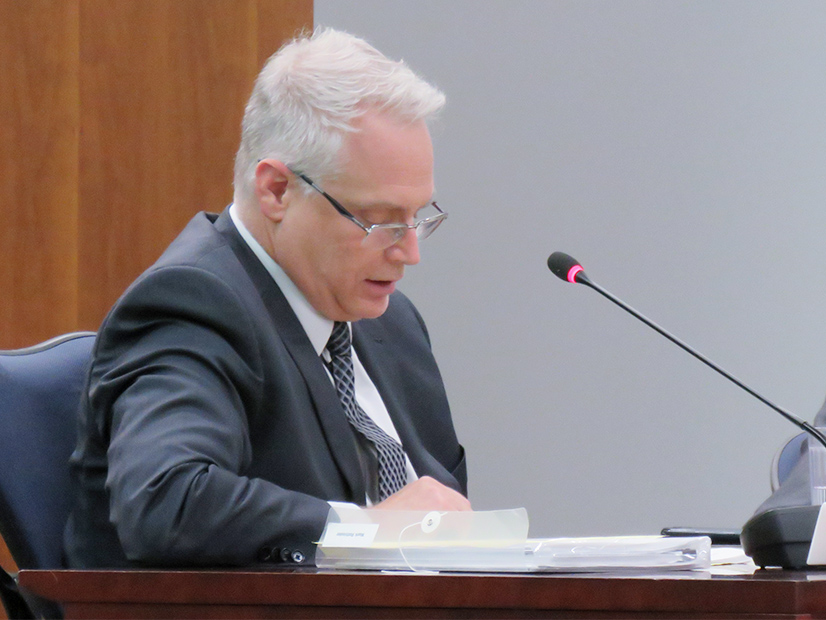
p.p1 {margin: 0.0px 0.0px 0.0px 0.0px; font: 11.0px ‘Helvetica Neue’; color: #000000}
Arizona regulators say CAISO’s proposed extended day-ahead market could be a good opportunity for utilities in the state if issues of governance and resource adequacy are satisfactorily resolved.
“Independence of the governing structure is something that will be critical for Arizona,” said Arizona Corporation Commission (ACC) member Justin Olson. “If the CAISO can get that worked out where we have an independent governing structure, and they can address the resource adequacy policies in California, then the CAISO becomes a very attractive market for Arizona utilities.”
Commission Chairwoman Lea Marquez Peterson expressed similar views.
“An independent governance structure will be essential to my support,” Marquez Peterson said.
The comments came during a special ACC meeting on Sept. 21, where CAISO gave a presentation on its proposed extended day-ahead market.
CAISO runs the Western Energy Imbalance Market (WEIM), a voluntary, real-time market that was launched in 2014. Arizona utilities participating in WEIM include Arizona Public Service, Salt River Project and Tucson Electric Power (TEP), which joined in April.
CAISO is exploring an expansion of WEIM through an extended day-ahead market (EDAM). The ISO has been gathering stakeholder feedback on its plan and released a revised EDAM straw proposal in August. (See CAISO Updates EDAM Straw Proposal.)
In August 2021, an enhanced governance framework was approved for WEIM, in which decisions on certain issues are made through the joint authority of CAISO’s Board of Governors and WEIM’s Governing Body. The five members of the board of governors are nominated by the California governor and confirmed by the state Senate. The five members of the WEIM Governing Body are chosen through a stakeholder process, according to Stacey Crowley, CAISO’s vice president of external affairs.
Now, the WEIM’s stakeholder-run Governance Review Committee (GRC) has proposed extending the joint authority model to EDAM, Crowley said. GRC is asking for feedback on what types of decisions should be made through the joint authority.
Marquez Peterson said she’d like to see the joint authority widely applied.
“Ensuring that our voices are heard, and that we have the broadest extent of joint authority — that’s the direction I’d like to encourage,” she said.
Consequences Considered
Resource sufficiency is another issue being hammered out in the EDAM straw proposal. EDAM is not intended as a way for participants to bolster energy supplies when their own resources fall short, said CAISO COO Mark Rothleder. Instead, participants have more options for buying energy, potentially saving money.
The straw proposal would require EDAM participants to pass a day-ahead resource sufficiency evaluation (RSE).
“What exactly [do] you anticipate would be the policy if somebody does not have that day-ahead resource sufficiency?” Olson asked Rothleder.
Rothleder said two possible consequences are being discussed. One of those is a surcharge for failing to meet sufficiency requirements. In addition, he said, stakeholders are weighing whether there should be an “ultimate consequence” for resource insufficiency.
“If things go really bad, should you be able to still rely on those transfers, potentially impacting somebody else?” Rothleder said. “Potentially, the answer is ‘no.’ If you get in that position, and you’re not sufficient on your own, you shouldn’t be able to still rely on those transfers at the same level, or the same level of priority, as someone who did pass.”
Marquez Peterson asked what happens if CAISO is insufficient.
“If we are insufficient, we will follow the consequences,” Rothleder said.
Heat Wave Response
Rothleder also discussed CAISO’s response to the heat wave that scorched California from Sept. 5-9. Rolling blackouts were narrowly averted during the record-setting event, in which CAISO saw demand reach an all-time record of 52,061 MW on Sept. 6. (See California Runs on Fumes but Avoids Blackouts.)
Since the state’s rolling blackouts in August 2020, California has added more than 6,000 MW of capacity, including about 3,700 MW of battery storage. That capacity helped CAISO handle increased loads during the heat wave, Rothleder said. In addition, he said, coordination with other agencies has been improved.
And a few other factors worked in CAISO’s favor, Rothleder said. The heat wave hit the Pacific Northwest a bit earlier, taking some of the pressure off when high temperatures arrived farther south. Hydroelectricity was more available than usual for the time of year. And although temperatures in Arizona reached 107 or 108 degrees, the heat there wasn’t considered extreme, he said.
“This is very alarming to say the least,” Marquez Peterson said. “Without a moderate weather event in Arizona, California ratepayers would have been at public health and safety risk.”
In response to a question from Commissioner Sandra Kennedy, Rothleder acknowledged that CAISO was receiving emergency assistance from Arizona utilities and paying prices above $1,000/MWh.
Sam Rugel with TEP described the situation as “excellent for the ratepayers.”
“Being in the EIM, we were exporting throughout the day, day and night, into the Cal ISO market, in real time,” Rugel said. “And that does roll back to the ratepayers.”
But Rugel said the situation raises questions about resource adequacy.
“As much as this helps the neighbors … they should not be in this situation,” he said.
Regional Markets Explored
The ACC opened a docket last year for the purpose of investigating regional planning, markets and collaboration among load-serving entities in the Western Interconnection.
As part of its research, ACC heard a presentation in August from SPP on its Markets+ proposal, a program under development that will include a day-ahead market in the West.
In September, SPP announced that four Arizona utilities — Arizona Electric Power Cooperative, Arizona Public Service, Salt River Project and Tucson Electric Power — plan to support the next phase of Markets+ development. (See 4 Arizona Entities Commit to Developing SPP’s Markets+.)
ACC’s Utilities Division expects to file a report on regional planning and markets issues by the end of October.


